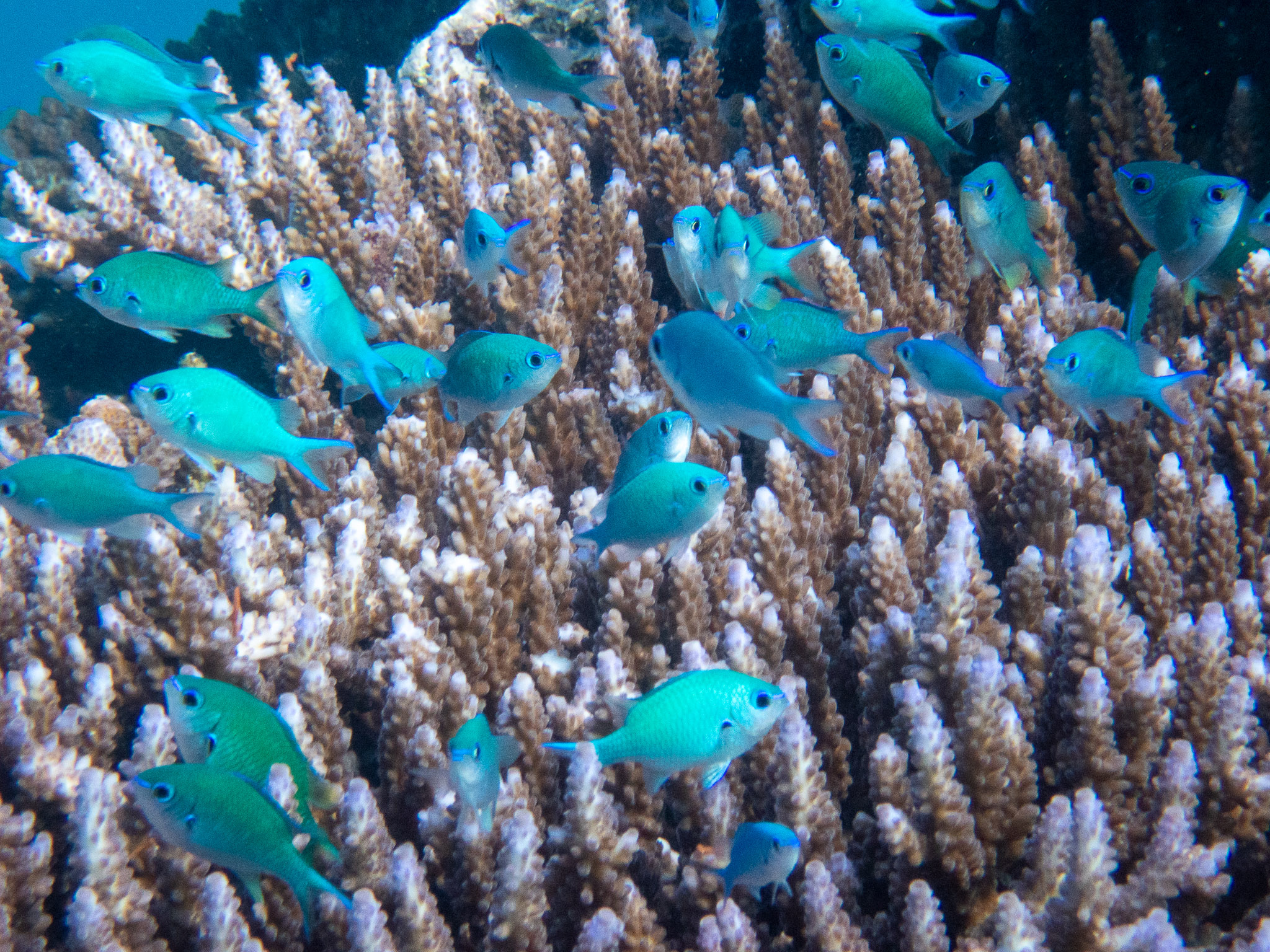I first visited John Brewer Reef on 10th April 2022, it was being reported in newspapers around the world as badly bleached – part of a sixth mass coral bleaching at the Great Barrier Reef.
I had expected to find stark white corals, instead I found the most truly colourful coral reef. My favourite section had massive, what are known as plate corals – round and flat, arranged such that they were overlapping, and hanging over a deep crevasse. The large plates were in different shades of pink with some beige, chocolate brown and green. And the fish, they were so beautiful; especially the clouds of green Chromis swaying with the current along the reef edge.
This coral reef rises as a block of limestone topped with these most spectacular corals jostling for space across the reef crest. The limestone platform, that is John Brewer Reef, rises from the sandy sea floor 70 kilometres offshore from Townsville – it is part of the central Great Barrier Reef.
Of course that afternoon of 10th April there were parrot fish, with their large beaks for scraping and breaking the hard corals – and I swear one of the more colourful parrot fish in shades of green, blue and yellow, I swear it winked at me as it gobbled a morso of coral.
It was a sunny day. The water was warm and crystal clear – everything sparkled. This was a reef making headlines around the world as badly bleached, and yet it presented as the very best of the Great Barrier Reef.
In fact, it was more colourful than usual, because it was stressed. Most people expect to see colourful corals at the Great Barrier Reef when in fact at a healthy reef most of the corals, much of the time, are brown to beige in colour. It is typically the fish, especially the parrots and the yellow butterfly fish – I also saw red damsels, gold spotted sweetlips, orange clowns at John Brewer reef that first day – that give a reef movement, and colour.
It is only when the corals lose some of their symbiotic algae that the more colourful florescent proteins show through. This was happening at John Brewer Reef in March to April 2022 – at the end of that summer, many of the more usually brown corals, especially along the outer edge of the crest, had lost a lot of their symbiotic algae, their zooxanthellae, and they were now pinker because the more colourful pink florescent proteins usually masked by the algae was showing through. John Brewer reef not only had colourful fish, but also the pinkest corals I had ever seen.
Because John Brewer reef, like most mid-shelf coral reefs is essentially layer upon layer of dead coral that has built up over the millennia as a hard limestone platform, it is just the top that is alive. It has just a thin veneer of colour – like the icing on layers of a sponge cake, except the sponge is as hard as concrete.
On that sunny day in April 2022, when I first visited John Brewer reef, most of the snorkelers were concentrated over this area: inspecting the colourful top of the platform, this special reef habitat where the coral is concentrated: the reef crest. And I especially liked that area of this hard top where there was some cracking – some cracking so I could see down between the plate corals into the crevasse. And I might have seen yet another parrot fish, as it looked up at me from the dark blue, from the abyss into the sunshine – did it wink at me?
Of course, it is this most exposed top – the reef crest – that is also that section of reef that will receive the full force of crashing and pounding waves during storms and cyclones.
So, when Tropical Cyclone Kirrily hit John Brewer reef as it did on that afternoon of Thursday 25th January 2024, as a severe tropical cyclone with 224 km per hour winds and huge waves, it was the reef crest, where the tourists take so many photographs as memories, that was most affected, that was pummeled.
While it is the reef crest that is always the focus of the tourist camera, where the fish swim amongst the highest density of coral – before the cyclone – as I will explain, this section of reef was never surveyed as part of the Australian Institute of Marine Science (AIMS) Long Term Monitoring Program – so there is no record of coral cover before TC Kirrily, at least no record that was ever contributed to the calculation of total coral cover at the Great Barrier Reef.
Indeed, while some like to reduce the Great Barrier Reef to the magical number of 32.7 and claim record coral cover – this number has never included the reef crest, not at John Brewer or any of the other 3,000 coral reefs that make up the Great Barrier Reef.
To be continued.

This is part two of a new series, ‘Denying the Most Precious – Natural Cycles’. You can read Part 1 by CLICKING HERE. In this series I will explain why I have come to despise the rumpled, those who engage in premediated ignorance.
All photographs are mine, taken at the reef crest with an Olympus TG6.


 Jennifer Marohasy BSc PhD is a critical thinker with expertise in the scientific method.
Jennifer Marohasy BSc PhD is a critical thinker with expertise in the scientific method.

Please visit Lizard Island’s North Point reef.
Brilliant!